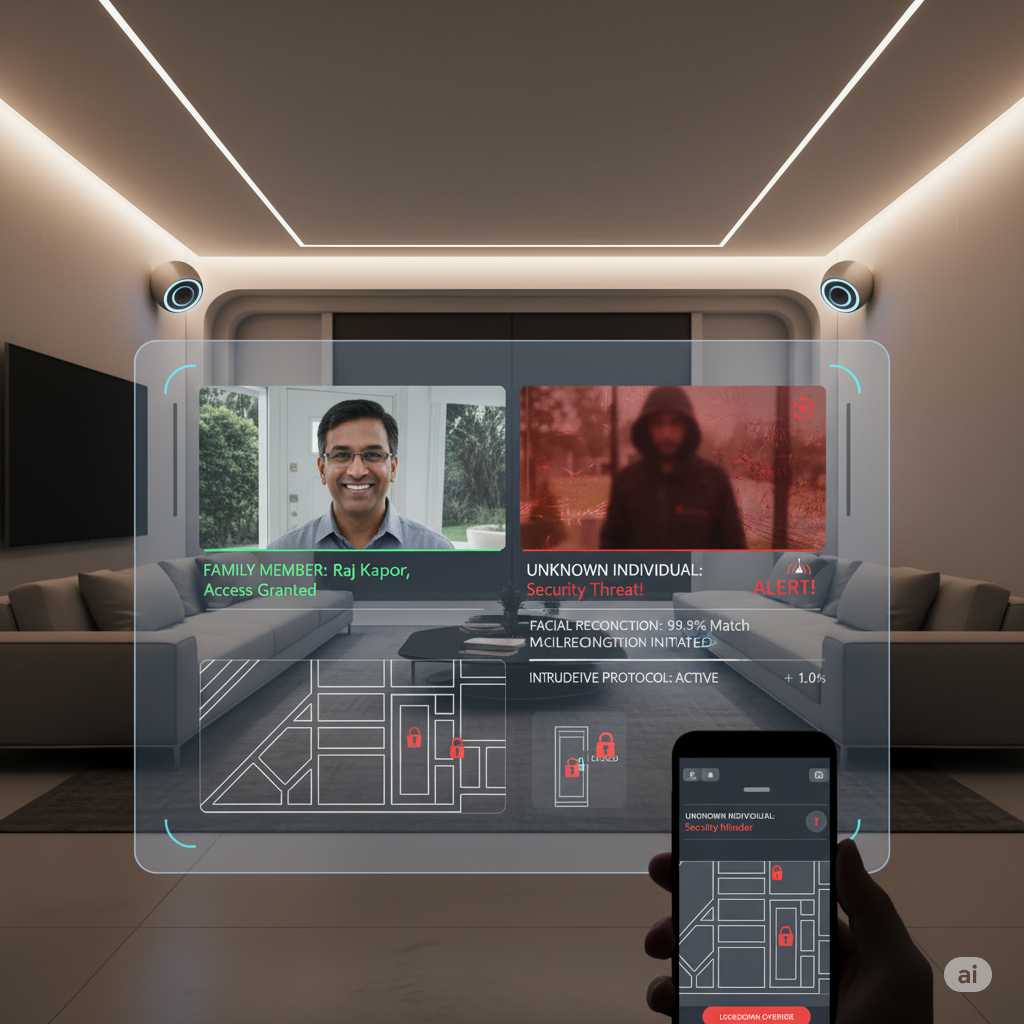Artificial intelligence (AI) is redefining every aspect of modern life — and home security is no exception. From AI security cameras to facial recognition home security systems, smart technologies are making our homes not only safer but also more responsive and efficient.
This blog explores how AI home security is transforming traditional surveillance into an intelligent early warning system that learns, adapts, and protects.
1. The Evolution of Home Security: From Passive to Proactive
Traditional security cameras recorded events — but often too late to prevent them. AI has changed that dynamic completely.
Today’s AI home security systems don’t just capture footage — they analyze, recognize, and respond in real-time. These systems can distinguish between normal household activity and potential threats, reducing false alarms and enabling faster reactions.
How AI Changes the Game
- Object Recognition: AI identifies people, pets, vehicles, and packages.
- Behavior Analysis: The system learns normal patterns and detects unusual movements.
- Predictive Alerts: Early warnings are triggered before incidents escalate.
🧩 In short, AI makes your security system proactive — not just reactive.
2. What Is AI Home Security?
AI home security refers to the integration of artificial intelligence into surveillance and monitoring systems. Using machine learning and deep learning algorithms, these systems analyze data from cameras and sensors to identify threats automatically.
Core components include:
- AI-powered cameras
- Facial recognition systems
- Motion and sound detection
- Cloud-based analytics
- Real-time mobile alerts
Explore an example:
👉 WeSecuu AI Camera Indoor Pan Tilt 2.4GHz Wi-Fi Security Camera — a smart indoor camera that combines AI motion tracking with two-way communication, ideal for real-time family monitoring.
3. Intelligent Identification: Beyond Simple Motion Detection
Traditional cameras trigger an alert for any movement — even from curtains swaying or pets walking by. AI changes this with intelligent identification.
Key Advantages:
- Facial Recognition: Identifies known faces and detects strangers.
- Pet & Human Differentiation: Prevents false alarms caused by pets or small objects.
- Smart Zone Detection: Allows users to focus on specific monitoring areas (e.g., doors, windows).
This level of accuracy is what defines next-generation home protection.
Check this product:
🔗 Window Security Camera — designed for smart motion detection and flexible indoor/outdoor use, perfect for renters or homeowners who value quick installation.
4. Facial Recognition Home Security: Personalized Protection
Facial recognition technology has moved from science fiction into everyday reality. It’s now one of the most powerful features of modern AI home security.
How It Works:
- The camera captures and analyzes facial features using AI algorithms.
- Recognized faces (like family members) are marked as “safe.”
- Unknown individuals trigger real-time alerts or recordings.
This feature is especially valuable for families who want to monitor access points or track visitors while away from home.
💡 AI doesn’t just “see” — it understands who is there.
5. Early Warning Systems: Predicting Threats Before They Happen
The biggest breakthrough of AI home security lies in early warning capabilities. Instead of passively waiting for something to happen, AI systems detect anomalies that predict potential issues — from suspicious movement patterns to lingering activity near entrances.
Common Use Cases:
- Detecting unfamiliar faces near doors or windows
- Identifying unusual motion around restricted zones
- Sending alerts before a potential intrusion
- Auto-tracking intruders in real-time
Some systems even integrate with smart lighting and alarms, turning on lights or sirens automatically when an unknown face is detected.
6. Integration with Smart Home Ecosystems
AI-powered cameras are now part of broader smart home ecosystems, connecting seamlessly with voice assistants and other IoT devices.
Examples of Integration:
- Voice Assistants: Use Alexa or Google Home to view live feeds or control devices.
- Smart Lighting: Lights turn on automatically when motion is detected.
- Door Sensors: Trigger cameras when doors or windows open unexpectedly.
This synergy between devices builds a fully connected smart security network — one that operates intelligently, even when you’re not home.
🔗 Learn more about integration trends: CNET Smart Home Guide
7. Privacy and Data Protection in AI Security
With great intelligence comes great responsibility. One of the main concerns about facial recognition home security is privacy.
Best Practices for Safe AI Use:
- Choose cameras with encrypted data transmission.
- Use two-factor authentication for your security apps.
- Store footage securely in cloud servers with privacy compliance (e.g., GDPR, CCPA).
- Regularly review access logs and permissions.
Reputable manufacturers now prioritize data security, ensuring that AI protection never compromises user privacy.
🛡️ Read more about responsible AI use from Electronic Frontier Foundation (EFF)
8. Real-Life Benefits of AI Home Security
| Feature | Benefit |
| AI Detection | Fewer false alarms and smarter alerts |
| Facial Recognition | Personalized security and identity verification |
| Smart Alerts | Instant notifications via mobile |
| Integration | Works with smart devices and home assistants |
| Early Warning | Prevents incidents before they happen |
Homeowners and tech enthusiasts alike are embracing these systems because they offer peace of mind, automation, and adaptability — all powered by artificial intelligence.
9. The Future of AI Home Security
The next phase of AI security involves predictive analytics and multi-sensor intelligence — combining video, sound, and motion data to provide context-aware alerts.
Imagine a system that can tell whether a person pacing outside is just a passerby or a potential intruder, or that can detect smoke and alert emergency services before you even notice.
This level of intelligent automation represents the future of smart home protection — and it’s coming faster than most people think.
🔍 Learn more about innovation trends from MIT Technology Review – AI and Security
10. Conclusion: A Smarter, Safer Home with AI
AI home security represents a leap forward from traditional protection — it’s adaptive, predictive, and intelligent. With tools like the
👉 WeSecuu AI Camera Indoor Pan Tilt Wi-Fi Security Camera
and
👉 Window Security Camera,
you can build an AI-driven defense system that learns your environment, recognizes faces, and sends early warnings before threats escalate.
For people passionate about technology, AI security cameras are more than just gadgets — they’re the next evolution in digital safety.


Portable Security Solution for Rental Users